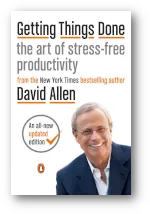If disorganization is your problem, I’m about to introduce you to a method to tackle it. But nothing is easy, so grab a pen and paper because you’ll need to put in some work. Let me show you what GTD is all about: Getting Things Done.
The GTD method is an organizational approach created by David Allen in his book Getting Things Done. It involves creating to-do lists, categorized by topic, and setting up an inbox where new tasks should go. GTD also defines a rule called the “2-Minute Rule,” which states that if a task takes less than two minutes to complete, it should be done right away.
Keep reading, and I’ll dive deeper into this productivity methodology.
What is GTD?
GTD stands for Getting Things Done and is a framework was created by David Allen and is presented and explained in detail in his book Getting Things Done.

Getting Things Done: The Art of Stress-Free Productivity
David Allen
A productivity method that helps organize tasks, reduce stress, and optimize time management for greater efficiency.
GTD is the solution for you if you struggle with managing your time. If you forget meetings, work deadlines, or lose important papers. But it’s also for you if you stay organized but want to maximize your time even further.
The book Getting Things Done contains the foundation of the GTD methodology.
You’re probably thinking: “I want that! What do I have to do? Where do I sign up? What do I need to buy?”
The answer is simple: just follow the method, and you can learn it directly from David Allen’s book.
If you don’t have the book, you can still find information online through blogs, videos, and websites that specialize in this system.
As for costs, it can be completely free, or if you prefer, you can invest some money in resources, courses, and tools that will help you get more organized.
What is the philosophy behind GTD?
David Allen talks about the concept of “mind like water.” It may sound like Eastern philosophy, but it’s actually pretty simple to understand. Let me explain.
According to Allen, people focus better when their mind is clear and free of worries. With this in mind, the author proposes separating two aspects of the tasks to be done.
On one side, there’s the what, when, and where a task needs to be done. On the other side, there’s the actual execution of it.
Allen believes that remembering what to do should not interfere with the act of doing it.
The idea behind GTD is for you to stop remembering your to-dos and focus on getting them done.
In other words, what this method seeks is for you not to have to remember what tasks need to be done, when, and where. All that information goes into a system, whether analog or digital.
This way, your mind won’t need to worry about reminders of any kind. It can just focus on getting the tasks done.
How is GTD implemented?
Well, enough mystery for now. What does this method actually consist of? Below, I’ll share some of the most important features of GTD.
Projects with Tasks to Solve
The main structure of GTD is to classify tasks and to-dos into projects. Each project represents an area of your personal, academic, or professional life. Let’s use some examples to make this clearer.
If you’re studying at university, you’ll have a project for each subject you’re taking. For example, History, Geography, and Math. But, of course, you’ll also have to deal with administrative tasks, like paperwork and other related things. So that would also be a project.
If you work in an office, you might have a single project for your work or several projects for each aspect of what you do (accounting, purchases, collections, etc.).
Additionally, you can have personal life projects like Home (household tasks), Bills (financial tasks), Outings (recreational tasks), and many others like these.
The creation of these projects, which act like folders, depends on your judgment and needs. You can create as many as you need—there’s no limit.
So, what will you store inside all these projects?
All the tasks you need to solve. And as new ones come up, you’ll add them. The ones you complete, you’ll mark as done.
To keep track of this, you can use a paper and pencil or an app.
I recommend checking out Todoist, as I consider it the best task management software available today. Plus, it has a free basic plan.
Specific GTD Projects
Beyond your personal projects, David Allen also recommends having two specific ones:
- Waiting For: Here, you’ll put all the tasks that are pending and don’t depend on you, but rather on waiting for something to happen before they can be completed.
- Someday / Maybe: This is where you’ll jot down all the activities you want to do someday in the future (take a trip, learn a language, etc.).
The Two-Minute Rule
This rule is one of the most important keys of the GTD methodology. The Two-Minute Rule states that if a task takes less than two minutes to complete, you should do it right away. So, replying to a short email, making a call, saving a paper or digital file—these are tasks that should be done immediately.
What’s the goal behind this simple rule? Not to waste time on administrative tasks that don’t deserve it. Postponing and scheduling a task requires some thinking, but there are tasks so short that if we postponed them, we’d be wasting time. That’s why they should be done on the spot.
The Two-Minute Rule says that if a task takes less than two minutes, it should be completed right away and not delayed.
Do you need to time the task? No, the “two minutes” are symbolic. What the author aims to achieve with this rule is to identify tasks that can be quickly completed. For practical purposes, they could take two, three, or even more minutes. Ideally, each person should define when a task can be resolved right away.
Inboxes
GTD uses the concept of an inbox or container to hold all new tasks.
It can be the same inbox as your email, or an actual one you have on your desk. It’s important to mark the places where new tasks will accumulate.
Absolute capture
It’s crucial in GTD: Getting Things Done to write down absolutely everything you have to do. Ideally, you should have a notebook that you always carry with you or, as I mentioned, an app like Todoist.
The GTD methodology requires that all pending tasks be captured, meaning they must be recorded on a medium that can be either digital or analog.
Task Processing
Depending on what you have to do, you will process the tasks.
Remember, if it can be done in less than two minutes, you should resolve it immediately according to the rule mentioned earlier. If not, you can delegate it or postpone it.
If it’s information that might be useful later, you should file it properly. It’s often necessary to review your task lists to check what you can get done ahead of time.
Information Filing
David Allen recommends setting up a filing system, and this is where you can invest a bit of money. But don’t worry, you don’t need to spend too much.
You’ll only need some typical office supplies: folders, markers, and a stapler.
If you want to invest a bit more, you can buy a label maker, which is an excellent organizational tool.
With a good filing system, you’ll avoid losing important documents.
GTD: Getting Things Done, a Method and Philosophy
If disorganization is a burden for you, then give this method a chance. And if you’re a productivity fan, I don’t know what you’re waiting for.
I’ve been implementing GTD for about 10 years now. It works wonders for me and allows me to work on many projects simultaneously.
Not only has it increased my productivity, but it has also reduced my stress level.
GTD: Getting Things Done works if you follow it exactly as David Allen explains in his book. That’s why it’s so important to have it and read it repeatedly.

Getting Things Done: The Art of Stress-Free Productivity
David Allen
A productivity method that helps organize tasks, reduce stress, and optimize time management for greater efficiency.
Find more content on Mentes Liberadas
That’s all for this article. I hope you enjoyed it.
You can make a donation to Mentes Liberadas through our Ko-Fi account. This way, you’ll be supporting the site, helping us create more content, resources, and online tools.
Thank you for taking the time to read.
See you in the next article on Mentes Liberadas.




